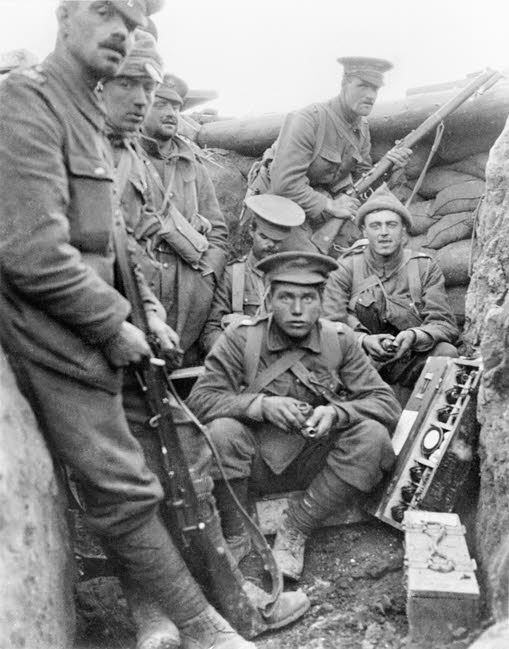British Ranks Devastated; Victims of Own Gas.
A Blatant, Needless Massacre.
Special to The Great War Project
(26-28 September) Day by day, the terrible scale of the British losses in the Battle of Loos in northern France is beginning to sink in.
On September 25th a century ago 10,000 British troops are ordered to walk across no-man’s land toward the German trenches, many through their own gas clouds, blowing back over the advancing British soldiers.
The Germans cannot believe their eyes. The British, according to a German account, “moved forward in ten columns, ‘each about a thousand men, all advancing as if carrying out a parade-ground drill…Never had machine guns had such straight-forward work to do.’”
The German guns mow the attackers down like blades of grass. “One machine-gun alone fired 12,500 rounds that afternoon.”
“The result was devastating,” writes historian Adam Hochschild, quoting the German account. “The enemy could be seen falling literally in hundreds, but they continued to march.”
“Hundreds of men have left descriptions of the Battle of Loos,” writes historian Martin Gilbert. One of those is the British writer Robert Graves, twenty years old at the time of the battle.
In his book Goodbye to All That, Graves relates one officer’s story. “When his platoon had run about twenty yards, he signaled them to lie down and open covering fire. The din was tremendous. He saw the platoon on the left flopping down too, so he whistled the advance again. Nobody seemed to hear. He jumped up from his shell-hole and waved and signaled ‘Forward.’ Nobody stirred.”
“He shouted, ‘you bloody cowards, are you leaving me to go alone?’ His platoon-sergeant, groaning with a broken shoulder, gasped out….
Not cowards, sir. Willing enough. But they’re all fucking dead.”
As with many episodes from this war, writes Hochschild, “it is hard for us to see the attack on September 26, 1915, as anything other than a blatant, needless massacre initiated by generals with a near-criminal disregard for the conditions their men faced.”
The Allies gained “a mile or two of ground.” The cost? More than 61,000 British casualties.
Historian Martin Gilbert writes of another young officer, Roland Leighton, who fought at Loos and writes to his fiancée Vera Britain that day: ‘Let him who thinks War is a glorious, golden thing, who loves to roll forth stirring words of exhortation, invoking Honor and Praise and Valor and love of Country…let him but look at a little pile of sodden grey rags that cover half a skull and a shin-bone and what might have been his ribs, or at this skeleton lying on its side, resting half crouching as it fell, perfect but that it is headless….
“Who is there that has known and seen, who can say that victory is worth the death of even one of these?”
Gilbert reports of one officer who served with a field ambulance during the Battle for Loos, “and noticed a phenomenon that had not been widely see on the battlefield since the retreat from Mons,” just a few weeks after the war began in August 1914.
Many of the younger soldiers, eighteen- and nineteen-year-old volunteers, “were patients sent to him from the front line with what the official medical history of the war describes as ‘definite hysterical manifestations (mutism and tremors).’”


